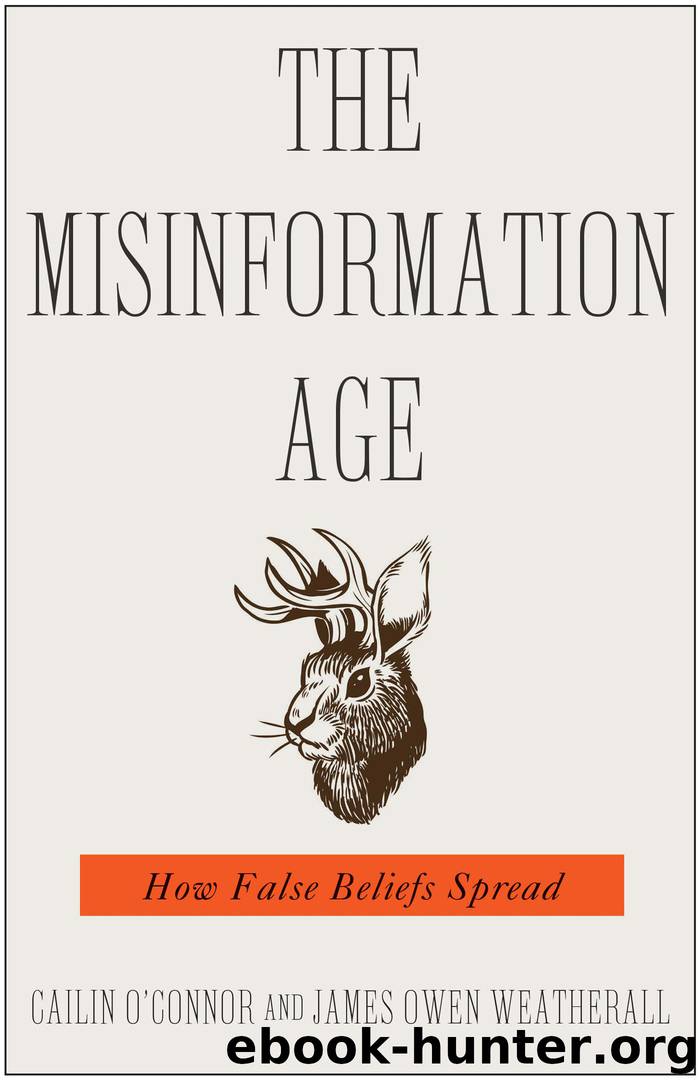The Misinformation Age by Cailin O'Connor & James Owen Weatherall

Author:Cailin O'Connor & James Owen Weatherall
Language: eng
Format: epub
Publisher: Yale University Press
Published: 2019-01-07T16:00:00+00:00
Figure 15. The spread of belief in a complete, that is, fully connected, network with conformity. Dark nodes represent one action, and light nodes, another. When multiple individuals in this network change actions, there is pressure on the rest of the group to change as well because of their desire to conform with neighbors. Once changed, the group is relatively stable.
In this chapter, we have looked at various ways in which propagandists can exploit how we share information and learn from one another to manipulate our beliefs and actions. The very same mechanisms that we saw in Chapter 2, which, remember, could both help us discover truth but also sometimes lead us astray, turn out to be levers for influencing our beliefs.
We have argued that there are multiple ways in which propagandists can succeed in this sort of manipulation. These can be as crude as producing scientific results that show precisely what you would like them to, or subtle, such as taking advantage of a scientific community’s tendency to occasionally produce spurious results, and then sharing those results—or selecting those scientists who are most likely to produce spurious results and favoring them with extra funding.
We also argued that the propagandist can exert influence by targeting members of a community who, for one reason or another, have special influence. In the cases of Roger Revelle, Ben Santer, and others, part of this method involved identifying figures who were especially trusted by the community. For instance, scientists whose record of success on other problems has been very high may persuade others who have been influenced by these scientists’ earlier work. A related method is to use conformity as a weapon by targeting individuals with particularly connected positions in the social network, or targeting cliques.
So far we have focused (mostly) on scientific communities and on the spread of information from scientists to others. But the same effects that influence scientists’ beliefs also operate, often in dramatic ways, in society at large. In the next chapter we expand the picture we have been presenting to try to understand the influence of social factors on day-to-day beliefs.
Download
This site does not store any files on its server. We only index and link to content provided by other sites. Please contact the content providers to delete copyright contents if any and email us, we'll remove relevant links or contents immediately.
| Anthropology | Archaeology |
| Philosophy | Politics & Government |
| Social Sciences | Sociology |
| Women's Studies |
Cecilia; Or, Memoirs of an Heiress — Volume 1 by Fanny Burney(32434)
Cecilia; Or, Memoirs of an Heiress — Volume 2 by Fanny Burney(31871)
Cecilia; Or, Memoirs of an Heiress — Volume 3 by Fanny Burney(31852)
The Great Music City by Andrea Baker(31348)
We're Going to Need More Wine by Gabrielle Union(18967)
All the Missing Girls by Megan Miranda(15568)
Pimp by Iceberg Slim(14393)
Bombshells: Glamour Girls of a Lifetime by Sullivan Steve(13972)
Talking to Strangers by Malcolm Gladwell(13222)
Norse Mythology by Gaiman Neil(13204)
Fifty Shades Freed by E L James(13157)
For the Love of Europe by Rick Steves(12977)
Mindhunter: Inside the FBI's Elite Serial Crime Unit by John E. Douglas & Mark Olshaker(9200)
Crazy Rich Asians by Kevin Kwan(9167)
The Lost Art of Listening by Michael P. Nichols(7406)
Enlightenment Now: The Case for Reason, Science, Humanism, and Progress by Steven Pinker(7228)
The Four Agreements by Don Miguel Ruiz(6630)
Bad Blood by John Carreyrou(6552)
Weapons of Math Destruction by Cathy O'Neil(6143)
